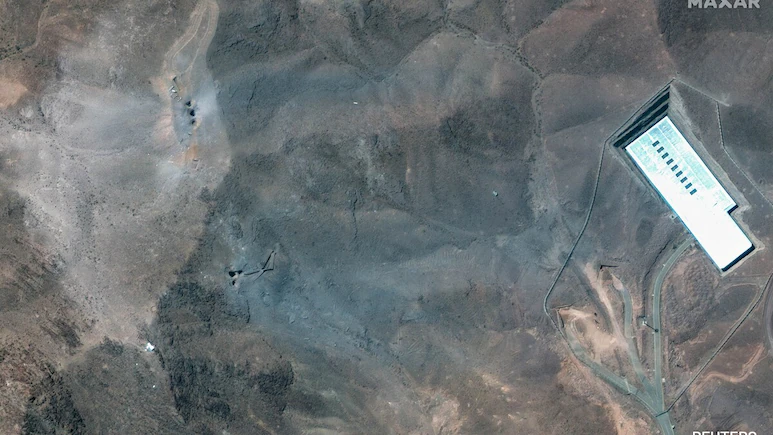Reports suggest Iran may have relocated its stockpile to a secret site just days before the attack, a claim echoed by Israeli officials in comments to The New York Times.
A 400kg stockpile of uranium—enough to produce up to 10 nuclear weapons, according to U.S. Vice President JD Vance in an interview with ABC News—has gone missing following last week’s U.S. airstrikes. Washington dropped six bunker-buster bombs on three Iranian nuclear sites, and the enriched uranium has not been accounted for since. Enriched to 60%, the uranium falls short of the roughly 90% enrichment level required for weapons-grade material, but it remains a critical asset for Iran as a potential bargaining tool in future nuclear negotiations with the U.S.

According to reports cited by Israeli officials in The New York Times, Iran may have relocated its stockpile and certain equipment to a secret location just days before the attack.
Prior to the U.S. strike, satellite imagery revealed a convoy of 16 trucks lined up outside Iran’s Fordow nuclear facility — a heavily fortified site built deep within a mountain and considered resistant to most missile attacks. In response, Israel requested that the U.S.
deploy its B-2 ‘Spirit’ stealth bombers armed with GBU-37 ‘bunker buster’ bombs.Early Sunday, those bombs targeted Iran’s key nuclear sites: Fordow, Natanz, and Isfahan.Post-strike satellite images showed significant damage to all three facilities — but the trucks seen earlier at Fordow had vanished.
It remains unclear what was moved or where it was taken, though the US and Israel strongly suspect it was relocated to another underground facility near the ancient city of Isfahan.
Rafael Grossi, head of the International Atomic Energy Agency (IAEA), said the site was last inspected a week before Israel launched its first strike on Iran. Speaking to the United Nations Security Council last week, Grossi emphasized that it is “essential” for the IAEA to resume inspections without delay.
He also cautioned that ongoing military escalation hinders crucial diplomatic efforts and reduces the likelihood of preventing Iran from obtaining nuclear weapons.
While Iran has consistently claimed its nuclear program is solely for peaceful purposes, concerns persist over its potential to produce weapons-grade nuclear material.
Israel cited Iran’s alleged nuclear weapons development as a key justification for its attack, warning that Tehran was approaching a “point of no return” in its nuclear ambitions. In the aftermath of the strikes, Iran threatened to withdraw from the Non-Proliferation Treaty (NPT), a cornerstone of global efforts to prevent the spread of nuclear weapons. However, Deputy Foreign Minister Takht Ravanchi dismissed any suggestion that Iran would abandon its nuclear programme, stating, “No one can tell us what to do.”
According to a CNN report last week, U.S. intelligence believes Iran is not actively pursuing nuclear weapons and remains at least three years away from being able to produce one. The report also indicates that Israel’s recent missile strikes only delayed Iran’s progress by a few months, as much of the nuclear research is housed deep underground in fortified sites like Fordow, which are largely impervious to Israeli attacks.
Confusion deepened over the weekend after U.S. Director of National Intelligence Tulsi Gabbard reversed her earlier statement to Congress, in which she had asserted that Iran was not pursuing nuclear weapons.
On Saturday, Gabbard warned that Iran could potentially produce a nuclear weapon “within weeks.” The abrupt shift followed President Donald Trump’s criticism of her prior testimony, calling it “wrong.”

Trump had previously given Iran a two-week deadline to agree to a new nuclear safeguard agreement. His administration moved quickly after intelligence revealed that Israel would be unable to effectively disable Iran’s nuclear facilities without U.S. support.
Table of Contents
“We’re not involved in it — but it’s possible we could be,” Trump said during an interview with ABC on Sunday morning, just hours before the U.S. launched an attack. He urged both Iran and Israel to reach an agreement independently, warning them to act “before it is too late.”
Following the strikes, Trump announced that Iran’s nuclear program had been “completely and totally obliterated” by precision ‘bunker buster’ bombs, supported by a wave of Tomahawk missiles launched as decoys. He praised the 37-hour military operation, which was carried out by seven B-2 stealth bombers flying radio silent and non-stop from an airbase in Missouri.















 Categories
Categories









